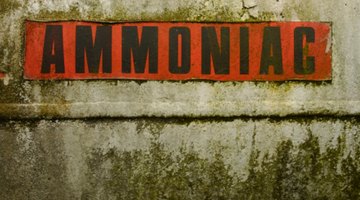How Do I Clean Up or Neutralize Phosphoric Acid?
Phosphoric acid is a relatively weak acid used in a surprising number of applications: rust removal, dentistry, disinfection, pharmaceuticals, food (just think of the bite in coca cola -- it's due to phosphoric acid) and antifreeze, to name but a few. (Ref 1 pg.

6) A spill of phosphoric acid is hazardous to both your health and the environment, however, and even used carefully it must still be neutralized and cleaned. By nature, acids are neutralized with bases. Using a suitable and convenient base substance and observing a few precautions will make clean up safe and fairly simple.
Things You Will Need
- Baking soda or powdered limestone
- Broom
- Dust pan
- Plastic trash bag
- Bucket
- Ammonia or alkaline dish detergent
- Mop or old cloths
- Eye goggles
- Acid-resistant gloves
- Respirator mask (optional)
Tip
Keep a supply of neutralizing agents handy when you work with acid, and have a ready source of water. Preparation is important when it comes to safety. Spills that come in contact with lawns and gardens may be treated with powdered lime, after rinsing the area well. (Ref 2)
Warning
Wear eye goggles, acid-resistant gloves and protective clothing when working with -- or cleaning up -- acid. A respirator mask is important in areas with no ventilation. Phosphoric acid will burn your eyes and skin. Take extreme care when handling it. If you get it in your eyes or on your skin, flush with cool water for 15 minutes and seek medical attention. (Ref 2,3,4)
-
Clear the area of other people. Fumes from the phosphoric acid alone are hazardous and the the neutralization process may cause the release of corrosive irritants such as chlorine gas. (Ref 2 - 4th parag. from bottom)
-
Ventilate the area thoroughly. Open windows and turn on fans to increase the air flow. Concentrated fumes from the acid and clean up are more toxic than diluted vapors. (Ref 2, par 4)
-
Sprinkle spills with either baking soda or powdered garden lime (both bases). (Ref 2, 7th par. from bottom) The amount to use will depend on the volume of the spill; use generously and work carefully to avoid splattering the phosphoric acid. If you are neutralizing a controlled use of acid, you don't have to sprinkle it with a base before cleaning, but it is still a good precaution.
-
Allow the base to sit on the acid, absorbing as it neutralizes. You should notice some fizzing, indicating it is working. (Ref 2, 4th par. from bottom) Give it several minutes to work and do not stand over it while you wait.
-
Sweep the sodden base and acid mixture up using a broom and dust pan. Dispose of the waste in a plastic trash bag, sealing it well before discarding. (Ref 3)
-
Mix a gallon of water, in a bucket, with either a cup of household ammonia (Ref 2 and 4 ) or enough of an alkaline dishwasher or dish detergent to create an abundance of suds. (Ref 5. pg. 4) All dishwasher and dish detergents are alkaline -- it makes them able to clean better and helps neutralize acids. However, detergents based on oxygen bleach or enzymes are less alkaline. Use a plain, higher alkalinity detergent for best results. (Ref 6)
-
Flood the area where the acid was with enough of the water to saturate the spot. Use a mop or old cloths, depending on the amount of acid that was involved and the location of the clean up, to swab the area. (Ref 2,5)
-
Rinse the area with fresh, clean water. Continue rinsing until the area is completely clean. Air-dry as desired. (Ref 2,5)
-
Flush your broom, dustpan and mop with plenty of water after neutralizing the surfaces. Throw cloths away along with the acid and base mixture. (Ref 3)


The Drip Cap
- Phosphoric acid is a relatively weak acid used in a surprising number of applications: rust removal, dentistry, disinfection, pharmaceuticals, food (just think of the bite in coca cola -- it's due to phosphoric acid) and antifreeze, to name but a few.
- ( By nature, acids are neutralized with bases.
- If you are neutralizing a controlled use of acid, you don't have to sprinkle it with a base before cleaning, but it is still a good precaution.
- Ref 3) Mix a gallon of water, in a bucket, with either a cup of household ammonia (Ref 2 and 4 ) or enough of an alkaline dishwasher or dish detergent to create an abundance of suds.
- ( Ref 2,5) Rinse the area with fresh, clean water.
References
- Environmental Protection Agency: Phosphoric Acid Listing Background Document for the Inorganic Chemical Listing Determination
- inman News; Cleaning Up After Contractor's Mortar Mess; Bill and Kevin Burnett
- NPS Corp: Specialty Spill Control
- Larence Berkeley National Laboratory: Control Procedures for Acids and Bases
- Choice: Dishwasher Detergent Danger
Writer Bio
Karie Fay earned a Bachelor of Science in psychology with a minor in law from the University of Arkansas at Monticello. After growing up in construction and with more than 30 years in the field, she believes a girl can swing a hammer with the best of them. She enjoys "green" or innovative solutions and unusual construction.
Photo Credits
- Brand X Pictures/Brand X Pictures/Getty Images
- Brand X Pictures/Brand X Pictures/Getty Images
- Jupiterimages/Comstock/Getty Images
- Hemera Technologies/AbleStock.com/Getty Images
More Articles



